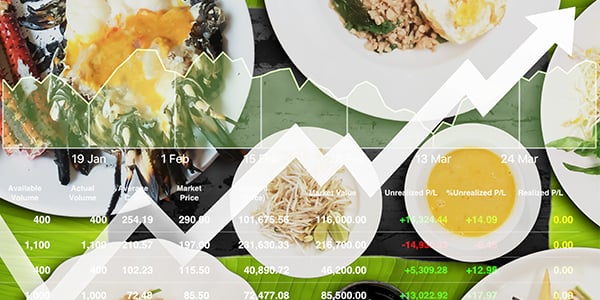The global coronavirus pandemic has dominated headlines for most of the year—especially since March 13, when the U.S. government declared the outbreak a national emergency. Fears about the health crisis have now been matched by fears of the economic crisis it has spawned.
Some foodservice segments—fine dining restaurants, for example—are feeling the effects of the COVID-19 crisis more than others. With on-premise dining still restricted in many states and consumers spending more than ever on groceries, average sales for all foodservice industry segments are down 65 percent.
The potential long-term impact could be staggering. Consider this: In mid-March, the National Restaurant Association predicted that 5 million to 7 million restaurant and foodservice jobs could be lost—and the industry itself could sustain a $225 billion loss—by June.
In late March, the International Food Manufacturers Association (IFMA) and Kinetic12 Consulting reported on the health and economic ramifications of COVID-19. “How we plan, how we go to market, how we communicate and collaborate, and how we interact with consumers is all going to be impacted,” they wrote. In a follow-up report on April 22, they observed that “consumer behaviors, needs and reactions will dictate much of what operators do next.”
To reassure anxious customers, operators have committed to new and expanded sanitation practices; eliminated self-serve salad bars, beverage stations and condiments pumps; and added or expanded carryout and delivery service. Our “new normal” (what McKinsey calls our “next normal”) is being determined in real time, but it seems certain there will be long-term changes to packaging, menu offerings, the supply chain and more.
Managing the Supply Chain More Collaboratively
As IFMA and Kinetic12 Consulting noted in March, one of the first actions operators took as the COVID-19 crisis spread “was to work with suppliers to understand their supply chain and sourcing risks.” (At the time of their report, 71 percent of food manufacturers were working with key operator customers to communicate supply availability, identify risks and perform contingency planning.) Although collaborations between operators and manufacturers have gotten progressively stronger over the past decade, these experts anticipate that the “ask-provide” dynamic will continue to evolve, with suppliers becoming strategic partners and operators demanding “greater visibility into processing, handling and distribution.”
When asked by Datassential to identify the most helpful type of product support business partners could provide, operators requested unlimited access to various resources, including cleaning supplies and food safety necessities (44 percent), to-go packaging and supplies (38 percent), and essential ingredients (31 percent).
Adopting New Approaches to Packaging
The rapid spread of the coronavirus brought a heightened awareness of how much we touch on a given day—and how many other people have touched those same objects. Now more than ever, consumers want assurance that anything they consume is both high-quality and safe.
To date, the industry conversation around food packaging has focused not only on the environmental advantages but also the higher costs such options bring. In their March 31 white paper, IFMA and Kinetic12 Consulting predicted that “Operators who were previously slow to adopt higher-cost tamper-proof options will now be much more open to them. Tamper-proof, food-safe ‘clean packaging’ will become the standard.”
By April 22, IFMA and Kinetic12’s thinking on packaging had evolved even further: “It goes without saying that packaging needs to change. This will be one of the greatest areas of immediate operator investment, which will be fueled by consumers’ willingness to pay for it. We may also see restaurants itemize on the bill ‘+$1.50 for tamper-proof delivery packaging.’ Delivery packaging will become a differentiator and part of an operator’s brand experience—and no longer be viewed as a cost to be minimized.”
Embracing New Concepts
Restaurant profitability will continue to take a hit once dine-in service resumes nationwide. Technomic anticipates that 32 percent of consumers will eat at restaurants less often. Research from Datassential suggests that 42 percent of consumers are wary of potential contact with other diners—and may avoid dining in as a result.
Takeout and delivery can take the pain out of reduced dine-in revenues, though only 14 percent of operators say they’ve seen enough growth in those areas to fully offset dine-in losses. Fast-casual operators like Panera Bread and Subway have even launched grocery concepts to make life easier for quarantined customers—and help offset lost on-premise revenue. While ordering off the menu for pickup or delivery, these customers can also request staples such as milk, fresh produce, bread and even toilet paper.
Meeting the Needs of Customers Where They Are
The coronavirus pandemic has significantly stymied the U.S. economy. Some 30 million Americans have filed for unemployment benefits since March 21. And 47 percent of consumers surveyed by Datassential in early April acknowledged that the crisis has forced them to tighten their belts financially.
Although four in 10 consumers plan to limit restaurant purchases and cook at home to save money after the immediate crisis passes, nearly a quarter of them will use more dining-related coupons. Nineteen percent will continue to eat out but will choose less expensive menu items.
What's Next?
When restaurants do reopen in all states, Americans are split on whether they’ll return to on-premise dining. According to Datassential research, four in 10 consumers won’t even consider dining in right away. The rest would “absolutely” do it (20 percent) or “might consider it” (39 percent).
For now, it does seem that Americans are more concerned about public health. “Off-premise will be the new normal—at least for a while,” Datassential Group Manager Mark Brandau said in an April 29 webinar hosted by IFMA. The restaurant experience may never be what it was, but one aspect of its reinvention seems certain. “Delivery and digital will go from niceties to necessities,” Brandau said. “That’s where the industry was heading anyway.”
Looking for an easy way to keep up with the latest COVID-19 and other news? Follow Clemens Foodservice on LinkedIn for more industry trends and insights.



